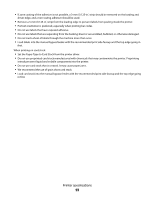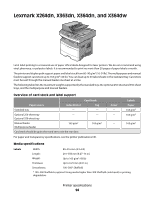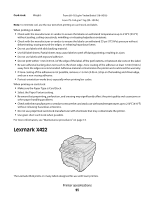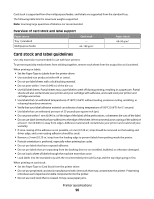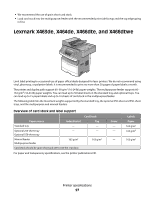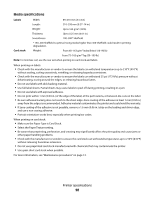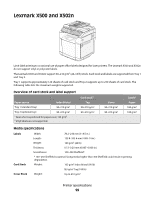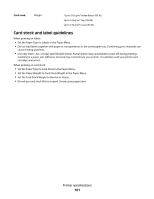Lexmark 25C0010 Card Stock & Label Guide - Page 98
Make sure the Paper Type is Card Stock., Select the Paper Texture setting.
 |
UPC - 734646054492
View all Lexmark 25C0010 manuals
Add to My Manuals
Save this manual to your list of manuals |
Page 98 highlights
Media specifications Labels Width: 89-216 mm (3.5-8.5) Length: 210-356 mm (8.27-14 in.) Weight: Up to 163 g/m2 (43 lb) Thickness: Up to 0.25 mm (0.01 in.) Smoothness: 100-300* Sheffield * 150-200 Sheffield is optimal. Using media higher than 300 Sheffield could result in printing degradation. Card stock Weight: From 60-163 g/m2 Index Bristol (16-90 lb) From 75-163 g/m2 Tag (50-100 lb) Note: To minimize curl, use the rear exit when printing on card stock and labels. When printing on labels: • Check with the manufacturer or vendor to ensure the labels can withstand temperatures up to 210°C (410°F) without sealing, curling excessively, wrinkling, or releasing hazardous emissions. • Check with the manufacturer or vendor to ensure the labels can withstand 25 psi (172 kPa) pressure without delaminating, oozing around the edges, or releasing hazardous fumes. • Do not use labels with slick backing material. • Use full label sheets. Partial sheets may cause labels to peel off during printing, resulting in a jam. • Do not use labels with exposed adhesive. • Do not print within 1 mm (0.04 in.) of the edge of the label, of the perforations, or between die-cuts on the label. • Be sure adhesive backing does not reach to the sheet edge. Zone coating of the adhesive at least 1 mm (0.04 in.) away from the edges is recommended. Adhesive material contaminates the printer and could void the warranty. • If zone coating of the adhesive is not possible, remove a 1.6 mm (0.06 in.) strip on the leading and driver edge, and use a non-oozing adhesive. • Portrait orientation works best, especially when printing bar codes. When printing on card stock: • Make sure the Paper Type is Card Stock. • Select the Paper Texture setting. • Be aware that preprinting, perforation, and creasing may significantly affect the print quality and cause jams or other paper handling problems. • Check with the manufacturer or vendor to ensure the card stock can withstand temperatures up to 210°C (410°F) without releasing hazardous emissions. • Do not use preprinted card stock manufactured with chemicals that may contaminate the printer. • Use grain short card stock when possible. For more information, see "Maintenance procedures" on page 13. Printer specifications 98



